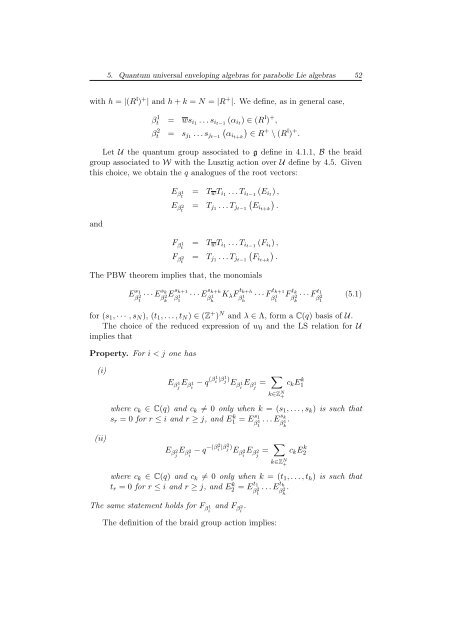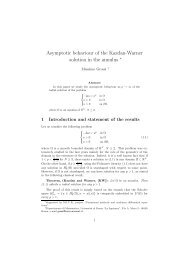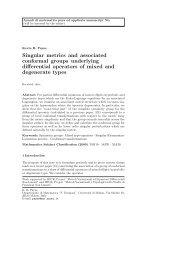Degree of Parabolic Quantum Groups - Dipartimento di Matematica ...
Degree of Parabolic Quantum Groups - Dipartimento di Matematica ...
Degree of Parabolic Quantum Groups - Dipartimento di Matematica ...
Create successful ePaper yourself
Turn your PDF publications into a flip-book with our unique Google optimized e-Paper software.
5. <strong>Quantum</strong> universal enveloping algebras for parabolic Lie algebras 52<br />
with h = |(R l ) + | and h + k = N = |R + |. We define, as in general case,<br />
β 1 t = wsi1 . . .sit−1 (αit) ∈ (R l ) + ,<br />
β 2 <br />
t = sj1 . . .sjt−1<br />
αit+k<br />
∈ R + \ (R l ) + .<br />
Let U the quantum group associated to g define in 4.1.1, B the braid<br />
group associated to W with the Lusztig action over U define by 4.5. Given<br />
this choice, we obtain the q analogues <strong>of</strong> the root vectors:<br />
and<br />
E β 1 t<br />
E β 2 t<br />
F β 1 t<br />
F β 2 t<br />
= TwTi1<br />
= Tj1<br />
. . .Tit−1 (Eit),<br />
<br />
. . .Tjt−1 .<br />
Eit+k<br />
= TwTi1 . . .Tit−1 (Fit) ,<br />
<br />
= Tj1 . . .Tjt−1 .<br />
Fit+k<br />
The PBW theorem implies that, the monomials<br />
E s1<br />
β 2 1<br />
· · ·E sk<br />
β2E k<br />
sk+1<br />
β1 1<br />
· · ·E sk+h<br />
β1 KλF<br />
h<br />
tk+h<br />
β1 h<br />
· · ·F tk+1<br />
β1 F<br />
1<br />
tk<br />
β2 · · ·F<br />
k<br />
t1<br />
β2 1<br />
(5.1)<br />
for (s1, · · · , sN), (t1, . . .,tN) ∈ (Z + ) N and λ ∈ Λ, form a C(q) basis <strong>of</strong> U.<br />
The choice <strong>of</strong> the reduced expression <strong>of</strong> w0 and the LS relation for U<br />
implies that<br />
Property. For i < j one has<br />
(i)<br />
(ii)<br />
E β 1 j E β 1 i − q (β1 i |β1 j ) E β 1 i E β 1 j = <br />
k∈Z N +<br />
ckE k 1<br />
where ck ∈ C(q) and ck = 0 only when k = (s1, . . .,sk) is such that<br />
sr = 0 for r ≤ i and r ≥ j, and Ek 1 .<br />
= Es1<br />
β 1 1<br />
. . .E sk<br />
β 1 k<br />
E β 2 j E β 2 i − q −(β2 i |β2 j ) E β 2 i E β 2 j = <br />
k∈Z N +<br />
ckE k 2<br />
where ck ∈ C(q) and ck = 0 only when k = (t1, . . .,th) is such that<br />
tr = 0 for r ≤ i and r ≥ j, and Ek 2 .<br />
The same statement holds for F β 1 i and F β 2 i .<br />
= Et1<br />
β 2 1<br />
. . .E th<br />
β 2 h<br />
The definition <strong>of</strong> the braid group action implies:








